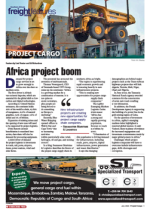As Mozambique gears up for the restart and initiation of several LNG projects in the north of the country, project cargo experts are already noticing an uptick in activity. According to Rufino Lambo, country C&F operations manager for LBH Mozambique, the excitement extends beyond developments in the gas industry to several other areas."Infrastructure development and significant investments in port and rail infrastructure are key drivers of the increase in project cargo volumes we are seeing," Lambo said. "Overall, the combination of infrastructural investments, supportive government policies, and increasing demand for resources are driving the growth of the project cargo sector in Mozambique."Renewable energy projects, including hydroelectric, solar, wind power, mining, and agricultural development, were all sectors offering opportunities, said Lambo. "Regarding more specific opportunities, Nacala port is a potential future hub for project cargo. Earlier this year, LBH Mozambique had the pleasure of being cargo and vessel agents for two project vessels calling back-to-back at the port. The first vessel discharged 16 000 freight tons, and the second loaded 7 500 freight tons. Both vessels had heavy-lift cargo over 50 mt."Sheila Mahomed, country C&F team manager, said Nacala port could serve as a buffer hub for project cargo destined for the LNG gas projects in Northern Mozambique. "These two vessels served as a good opportunity to test and understand the port's capabilities to handle this cargo. Traditionally, the port has handled container and dry bulk cargoes, so project cargo, although not new, is not a common throughput."With a general cargo berth totalling 372 metres in length and a draught of 14.0 metres, the two vessels could berth simultaneously. Currently, the port can work on one project cargo vessel at a time. "Despite the challenges, the port has seven 45-ton reach stackers, which are used effectively to move cargo on the quay. There is a total area of about 16 000 sqm that can be used for laydown," Mahomed added.She said the recent improvements to the Machipanda railway line had facilitated growth in the use of the railway between Beira and Zimbabwe, but rail freight rates remained high, although these improvements had only affected the section between Beira and the Machipanda border. “More improvements are still required on the Zimbabwe side of the border to maximise the capacity of the railway l i ne."Lambo and Mahomed emphasise that LBH is well-versed in overcoming Mozambique's logistics challenges, particularly in remote locations. The road conditions are very poor (especially north of Pemba), with a number of bridges on the route with a maximum load limit of 25t, which are often washed away during the rainy season. In many parts of the country, main national roads pass through villages, which results in frequent low speeds and stoppages by officials. Road conditions and lack of streetlights necessitate operating in daylight hours only.

